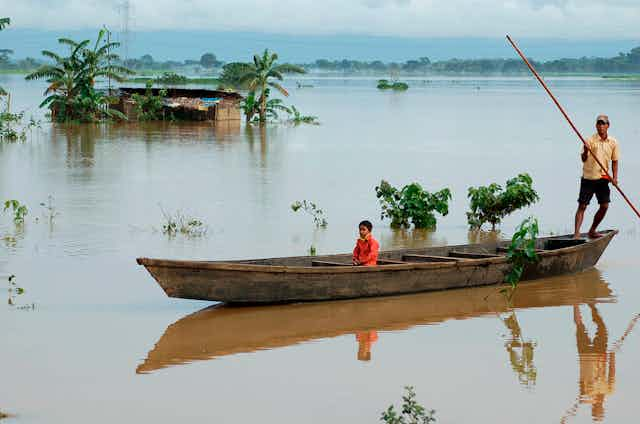The mighty Himalayas act as the water tower of the South and Southeast Asian region. More than ten major rivers originate from the Tibetan Autonomous Region of China. And for the past decade, India and China, the two biggest geopolitical forces in the region, have engaged in a hydro-power race to harness this power.
The waters that flow from the Himalayas know no borders. These rivers include the Brahmaputra, the Yangtze, the Mekong, the Sutlej, the Indus, the Salween, and the Huang Ho, which is also known as the Yellow River.
The Brahmaputra has a total length of 2,880 kilometres with a total drainage area of 5,73,394 square kilometres. It is shared by China, India, Bhutan and Bangladesh. The river is known as the Yarlung Tsangpo in China, the Siang and the Brahmaputra in India and the Jamuna in Bangladesh. The Brahmaputra is the lifeline for communities living along its banks.

The path of the Brahmaputra has sculpted the natural and human landscape of two north-eastern Indian states, Arunachal Pradesh and Assam. The river nourishes the young and fragile ecology of the Eastern Himalayas and the rich diversity of people and languages in this frontier space.
In recent years, the central governments of India and China have decided to tame the Brahmaputra, by building hydropower dams. Among them are the Lower Subansiri Project and the Dibang Valley project. As many as 168 memoranda of understanding have been signed between the Arunachal Pradesh state government and private and public dam-building companies to build medium and large dams in the state.

The legendary 20th century Assamese singer and composer, Bhupen Hazarika, mentions the Brahmaputra river in one of his popular compositions Bistirno Parore. He was influenced by the American standard, Ol’ Man River (Show Boat, 1936), sung by African-American artist Paul Leroy Robeson, who was involved in the American civil rights movement.
In his song, Hazarika asks the mighty Brahmaputra the reason for its quiet and unbounded flow, amid the suffering and pain of the people living by its banks.
Today, the song can be reinterpreted to reflect the great uncertainty and fear among the communities living in the Brahmaputra river basin, exhorting the river to answer back and not keep quietly flowing amid all the dam building.
In upstream Arunachal Pradesh, and downstream communities of Assam and Bangladesh, concern is widespread about plans to construct mega-dams by both China and India and water diversion infrastructure projects by China along the river system.

The size and scale of proposed infrastructure developments on this river, and the wider region, is unprecedented in the development history of northeast India. Indigenous communities of the region are worried they will face tremendous social and economic upheaval if the projects go ahead.
This may not go down well with Beijing. India’s policy of pursuing hydropower development in Arunachal Pradesh could have a negative impact on bilateral relations. New Delhi is essentially using this critical biodiversity hotspot to legitimise its sovereignty claims over Arunachal Pradesh by building mega hydroelectricity projects.

The Indian government’s hydropower obsession has led to great fear among local communities in Arunachal Pradesh and Assam, for the first time significantly overriding existing concerns about upstream dam building projects by China.
Recently, local people have taken to the streets in large-scale protests to voice their dissatisfaction.
The conversations around the Brahmaputra have been dominated by the Indian state, and this sits at odds with how the local communities think about the role the river plays in their own lives. India has to balance its strategic development interests with local community interests. Instead of its current aggressive approach, the government could assume a leadership role to initiate a basin-wide dialogue involving all the riparian stakeholder countries.
The way forward must be to highlight the Himalayan environment as an area of cooperation between all the South and Southeast Asian countries that share the transborder water resources in the region.
The only way to understand the Brahmaputra better is through a mix of modern research methods and traditional community-based knowledge systems. This approach should be central to any dialogue between and within the countries served by the river.
An emphasis on multilateral cooperation will dispel the prevailing sense of conflict on this crucial river. The Brahmaputra, meanwhile, meanders along ceaselessly, shifting between its moods of ferocious rampage and eternal quiet flow.
This is the first instalment of our ongoing series about water conflicts.

